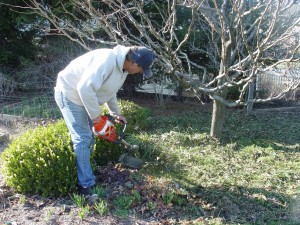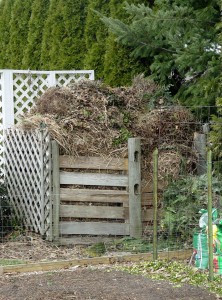Streamlined Cleanup
March 22nd, 2011
I hope you took advantage of the warm weekend (finally!) to get the landscape cleaned up and cut back for the new growing season.
This is my biggest spurt of gardening activity for the year since I go light on cleanup in fall, letting behind most leaves and dead foliage as winter insulation and bird food.
The last few winters gave us snow-free warm spells that were perfect for getting a jump on some things, like edging, pruning and spot cleanups. Not so this winter.
I got absolutely nothing done in the yard, other than carrying away the rootless remnants of my test ‘Home Run Pink’ shrub rose and a beautiful burgundy-and-lime-leafed ‘Alabama Sunrise’ foamybell – both of which were winter snacks for voles.
Now that I’m old enough that my joints need no excuse to ache, I’ve been trying to streamline some of this end-of-winter yard work.
Rather than get down to pull off or cut off dead perennial foliage, I’m using a rake, electric string trimmer and even power shears to do the deed.
An ordinary leaf rake works fine for perennial leaves that have flopped or are decayed enough to come off easily. That’s what I used to clean up my daylilies, hosta, ajuga, foamflowers, sweet woodruff and creeping veronica, for example.
For perennials that are brown but still standing, the string trimmer gets the job done pretty fast. I used mine to cut back leadwort (plumbago) groundcover, a patch of barrenwort and beds of hardy geraniums, coralbells and foamybells. Just be careful not to cut into the crown (the growing point) of any of those. Don’t go the whole way back to the ground, in other words.
The string trimmer saves a ton of work cutting back liriope. This versatile and durable little perennial with the grassy foliage still looks fairly green this time of year. But don’t be fooled.
In a few more weeks when the new shoots start to emerge, last year’s liriope leaves will brown out and start to look terrible. They don’t green up and go back to summertime form like some plants. The problem is, by then it’s much harder to get rid of the browned leaves while working around the new ones. Save yourself the trouble and whack the liriope leaves back to stubs now.
Some perennials are a bit too sturdy for even a string-trimmer cutback. If you’re under 50 or old-school, get out a pair of long-handled shears. If you’re north of 50 or just want to get the job done, use power shears.
I used my electric shears to cut back perennials such as mums, sedum, lavender, Russian sage, and, of course, ornamental grasses.
You know the trick to cutting down ornamental grasses the non-blow-around way, right? Rather than cut the whole bundle down and then try to pick up the blades before the wind blows them across the yard, make yourself a “grass straitjacket” before cutting.
Get some twine or jute and wrap it tightly around the midsection of the bundle of grass. Then use your shears (or chainsaw) to cut through the bundle a few inches off the ground. The whole thing will topple like a tree, and you (or your spouse) can carry it away already packed up.
One last whackback is the shrub roses. A question I hear a lot is, “How do I prune ‘Knock Out’ roses?” I think they look best when cut back very hard at the beginning of each season.
By that, I mean buzzing right through them at about ankle high. These are so tough that you don’t have to get cute.
I was once talking to Steve Hutton, the CEO at Conard-Pyle Co., about how they prune the thousands and thousands of ‘Knock Outs’ they were growing at the time for the wholesale market. He said they used a farm flail to go down the rows, decapitating the ‘Knock Outs’ at ankle level. A flail is a machine with sharp, whirling blades that spin horizontally. It’s a whole lot more like a gas-powered, sideways guillotine than hand pruners. It’s definitely not a delicate operation. So if you need to take out some frustrations, your ‘Knock Out’ roses would be a good choice.
‘Knock Out’ roses don’t have to be pruned if you’re OK with them growing more like 6 feet tall and wide instead of 4 feet. I usually give mine two cuts a year – the March mincing and then a lighter trim after the first main flush ends in June. This second cut not only refreshes the plant and keeps it compact, it forces a bloom shutdown for a couple of weeks while the Japanese beetles are out anyway.
I rake and compost all of my end-of-winter cuttings, by the way. The shrub and tree prunings and the woodier perennials get run through my chipper-shredder and get dumped on the beds as mulch.
The rest just get piled up on what’s now Mount Compost.
Holland Here We Come
The flower-friendly little country of Holland stages one of Earth’s most amazing plant spectacles only once every 10 years.
It’s called the Floriade, and it’s a sort of gardening Olympics in which countries from all over the world set up horticulture displays in a huge park-like setting. The Dutch go absolutely bonkers with bulb displays, such as spelling out the word “Floriade” in tulips over the size of a football field.
Lowee’s Group Tours and I have put together a nearly 2-week trip for next April to go see Floriade 2012 – plus all sorts of other cool Dutch attractions, like the Keukenhof gardens, the palace gardens at Het Loo, a real working bulb farm, the Aalsmeer flower market, the Zaanse Schans living history village, the Anne Frank House, the Rijksmuseum, a few private gardens behind those skinny Amsterdam canal houses, a visit to the Delft Pottery factory and lots more.
If you’re at all interested, there’s a free informational night coming up Mon., April 4, at 6 p.m. at the Hampden Inn along Union Deposit Road, Lower Paxton Twp. We’ll show you what we’re going to see and go over the planned itinerary.
Let Lowee’s know if you’re planning to come so they know how many to plan for. Call 657-9658 or email CKelly@lowees.com.











